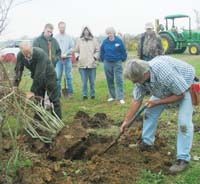Workshop Shows Proper Digging, Transplanting Methods
Workshop Shows Proper Digging, Transplanting Methods

Changes in blueberry research provided an opportunity recently for University of Kentucky Cooperative Extension Service specialists to teach proper digging, transplanting and pruning procedures for plants and trees.
After 11 years, a number of blueberry plants are being removed from the UK Research and Education Center to make way for new varieties in the research efforts. The plants have many productive years left and workshop participants were able to take some home.
Winston Dunwell, UK Extension horticulture specialist, demonstrated proper digging techniques, including tools needed and proper tool care and maintenance.
“For those that just do this in their yards and only occasionally, traditionally I tell them not to worry about spades or burlap," he said. "I just tell them to dig it as fast as you can and move it as quickly as you can and water it. Ninety-nine percent of the time that is adequate.”
If you can’t replant right away, make sure it is in a root ball. If the root ball falls apart in the digging process, make an artificial one using dirt, compost or media and burlap to keep the smaller fibrous roots alive.
“You can move trees bare root almost year round with success, it’s a matter of how fast you do it and taking good care of it once it is moved,” Dunwell said. "Watering immediately after planting is important.”
When moving shrubs, tying up branches will help protect them and keep them out of the way during the transplanting process, he said.
When preparing to move a plant, Dunwell uses his sharpened spade to remove weeds and grass from the surrounding area. There are standards available on the Internet from the
American Nursery and Landscape Association on the size root ball a plant needs to survive transplanting, he said.
Joe Masabni, UK Extension fruits and vegetables specialist, who is conducting the blueberry research, demonstrated how to prune plants to provide maximum benefit. Blueberries are better pruned in the spring after any danger of winter kill has passed.
Masabni also highlighted the importance of proper plant spacing and irrigation, especially blueberries for plants to become well establish and produce quality fruit.
“We think we have lots of rain in the spring and have heavy soils that retain lots of water, but it is not enough,” he said. “Research after research has shown that irrigation is necessary in the first few years of establishing young blueberry plants.”
Continuing efforts in blueberry research at UKREC will include plantings of southern highbush and rabbiteye blueberries. Research on these two species will involve adaptation to Kentucky and include variety evaluation as well as weed control.
For more information on transplanting trees and shrubs or blueberry production contact a countyCooperative Extension Service office.
-30-
